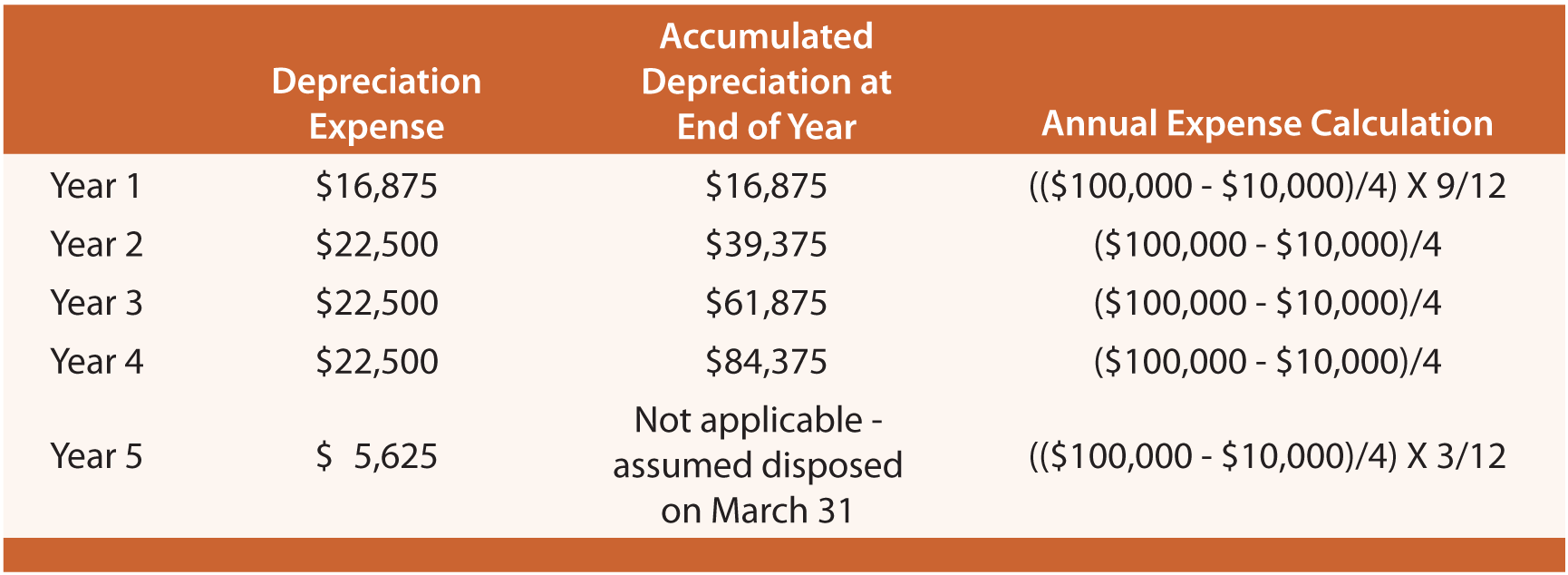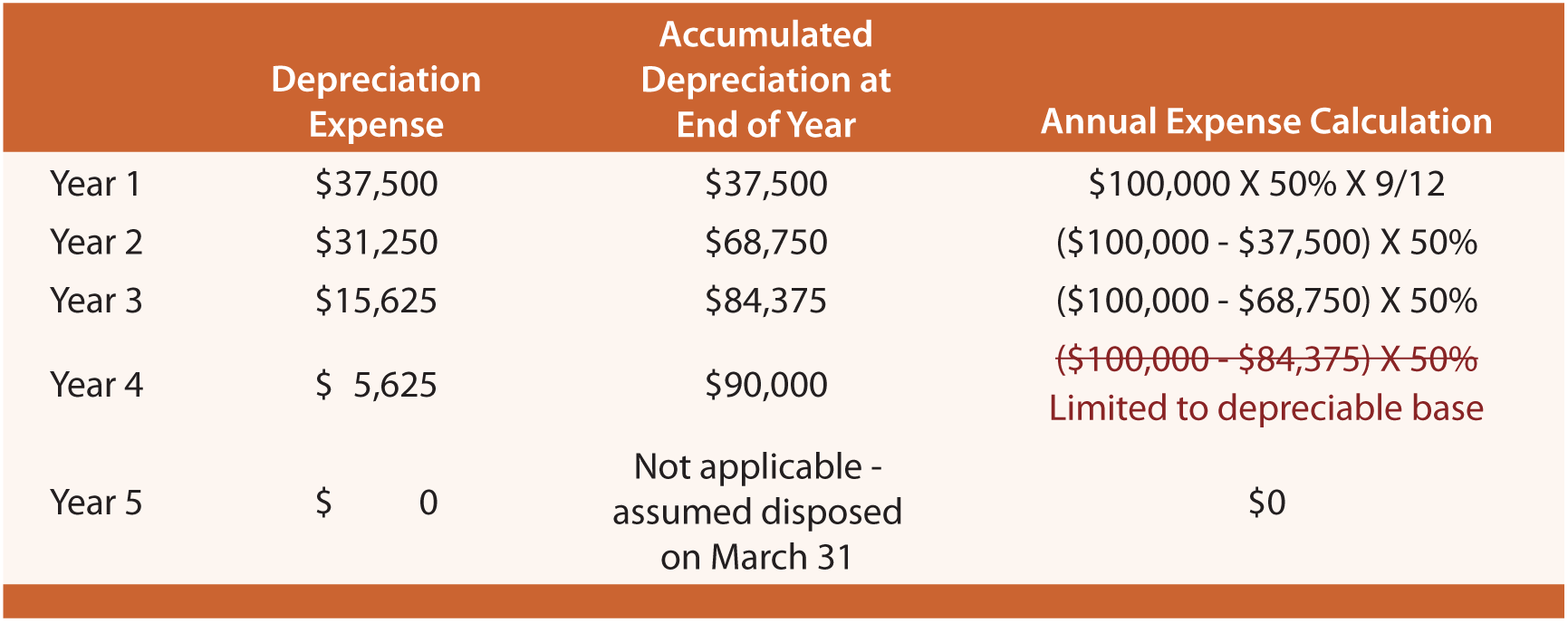
- •Property, Plant, and Equipment
- •Cost assignment
- •Lump-sum acquisition
- •It is important to note that the preceding allocation approach would not be used if the asset package constituted a “business.” Those procedures were briefly addressed in the previous chapter.
- •Judgment
- •Inadequacy -- An economic determinant of service life which is relevant when an asset is no longer fast enough or large enough to fill the competitive and productive needs of a company.
- •Depreciation methods Depreciation Concepts
- •Some important terminology
- •In any discipline, precision is enhanced by adopting terminology that has very specific meaning. Accounting for pp&e is no exception. An exact understanding of the following terms is paramount:
- •The straight-line method
- •The double-declining balance method
The straight-line method
Under the straight-line approach the annual depreciation is calculated by dividing the depreciable base by the service life. An asset that has a $100,000 cost, $10,000 salvage value, and a four-year life would produce the following amounts:

For each of the above years, the journal entry to record depreciation is as follows:

The applicable depreciation expense would be included in each year’s income statement (except in a manufacturing environment where some depreciation may be assigned to the manufactured inventory, as will be covered in the managerial accounting chapters later in this book). The appropriate balance sheet presentation would appear as follows (end of year 3 in this case):

FRACTIONAL PERIOD DEPRECIATION (SL)
Assets may be acquired at other than the beginning of an accounting period, and depreciation must be calculated for a partial period. With the straight-line method the amount is simply a fraction of the annual amount. For example, an asset acquired on the first day of April would be used for only nine months during the first calendar year. Therefore, Year 1 depreciation would be 9/12 of the annual amount. Following is the depreciation table for the asset, this time assuming an April 1st acquisition date:

THE UNITS-OF-OUTPUT METHOD
The units-of-output method involves calculations that are quite similar to the straight-line method, but it allocates the depreciable base over the units of output rather than years of use. It is logical to use this approach in those situations where the life is best measured by identifiable units of machine “consumption.” For example, perhaps the engine of a corporate jet has an estimated life of 50,000 hours. Or, a printing machine may produce an expected 4,000,000 copies. In cases like these, the accountant may opt for the units-of-output method. To illustrate, assume Dat Nguyen Painting Corporation purchased an air filtration system that has a life of 8,000 hours. The filter cost $100,000 and has a $10,000 salvage value. Nguyen anticipates that the filter will be used 1,000 hours during the first year, 3,000 hours during the second, 2,000 during the third, and 2,000 during the fourth. Accordingly, the anticipated depreciation schedule would appear as follows (if actual usage varies, the schedule would be adjusted for the changing estimates using principles that are discussed later in this chapter):

The form of journal entry and balance sheet account presentation are just like the straight-line illustration, but with the revised amounts from this table.
The double-declining balance method
As one of several accelerated depreciation methods, double-declining balance (DDB) results in relatively large amounts of depreciation in early years of asset life and smaller amounts in later years. This method can be justified if the quality of service produced by an asset declines over time, or if repair and maintenance costs will rise over time to offset the declining depreciation amount. With this method, 200% of the straight-line rate is multiplied times the remaining book value of an asset (as of the beginning of a particular year) to determine depreciation for a particular year. As time passes, book value and annual depreciation decrease. To illustrate, again utilize the example of the $100,000 asset, with a four-year life, and $10,000 salvage value. Depreciation for each of the four years would appear as follows:

The amounts in the above table deserve additional commentary. Year 1 expense equals the cost times twice the straight-line rate (four-year life = 25% straight-line rate; 25% X 2 = 50% rate). Year 2 is the 50% rate applied to the beginning of year book value. Year 3 is calculated in a similar fashion.
Note that salvage value was ignored in the preliminary years’ calculations. For Year 4, however, the calculated amount (($100,000 - $87,500) X 50% = $6,250) would cause the lifetime depreciation to exceed the $90,000 depreciable base. Thus, in Year 4, only $2,500 is taken as expense. This gives rise to an important general rule for DDB: salvage value is initially ignored, but once accumulated depreciation reaches the amount of the depreciable base, then depreciation ceases. In the example, only $2,500 was needed in Year 4 to bring the aggregate depreciation up to the $90,000 level.
An asset may have no salvage value. The mathematics of DDB will never fully depreciate such assets (since one is only depreciating a percentage of the remaining balance, the remaining balance would never go to zero). In these cases, accountants typically change to the straight-line method near the end of an asset’s useful life to “finish off” the depreciation of the asset’s cost.
FRACTIONAL PERIOD DEPRECIATION (DDB)
Under DDB, fractional years involve a very simple adaptation. The first partial year will be a fraction of the annual amount, and all subsequent years will be the normal calculation (twice the straight-line rate times the beginning of year book value). If the example asset was purchased on April 1st of Year 1, the following calculations result:

ALTERNATIVES TO DDB
150% and 125% declining balance methods are quite similar to DDB, but the rate is 150% or 125% of the straight-line rate (instead of 200% as with DDB).
Asset Revaluation
International accounting and reporting standards include provisions that permit companies to revalue items of PP&E to fair value. When applied, all assets in the same class must be revalued annually. Such balance sheet adjustments are offset with a corresponding change in the entity’s capital accounts. These revaluations pose additional complications because they result in continuous alterations of the amount of depreciation.
It is important to note that tax methods and financial accounting methods are not always the same. This is certainly true when it comes to the subject of depreciation. For example, when the economy “slows down” governments will often try to stimulate economic investment activity by providing special incentives that are realized through rapid depreciation for tax purposes (even immediate write-off in some cases). The depreciation causes a decrease in taxable income and a company’s tax obligation. This feature can provide significant incentives for capital investment.
The history of tax laws is marked by many changes to the depreciation rates and methods. As a result, it is difficult to generalize. But, one depreciation technique is known as the Modified Accelerated Cost Recovery System (MACRS, pronounced “makers”). MACRS provides for a general depreciation system and an alternative system. Within those systems are generally provisions relating to the 200% declining balance, 150% declining balance, and straight-line techniques.
Further, tax systems will generally stipulate the useful life of an asset rather than leaving it to the imagination of the taxpayer. Tax codes tend to be very complete in identifying assets and their lives. Tax codes tend to be “favorable” to taxpayers, and generally result in depreciation occurring at a faster rate than under generally accepted accounting principles.
Is it bothersome that a company would use one accounting method for financial reporting and another for tax? Consider that accounting rules are about measuring economic activity of a business and require a proper scheme for assigning revenues and costs to time periods. Meanwhile, tax codes must be followed and often change to meet the revenue or social objectives of the government. As a result, temporary (and sometimes not so temporary) differences will arise between accounting and tax measurements. Records of these differences must be maintained, making the accounting task all the more challenging for a complex business organization.
Many businesses acquire needed assets via a lease arrangement. With a lease arrangement, the lessee pays money to the lessor for the right to use an asset for a stated period of time. In a strict legal context, the lessor remains the owner of the property. However, the accounting for such transactions looks through the legal form, and is instead based upon the economic substance of the agreement.
If a lease effectively transfers the “risks and rewards” of ownership to the lessee, then the applicable accounting rules dictate that the lessee account for the leased asset as though it has been purchased. The lessee records the leased asset as an item of property, plant, and equipment, which is then depreciated over its useful life to the lessee. The lessee must also record a liability reflecting the obligation to make continuing payments under the lease agreement, similar to the accounting for a note payable. Such transactions are termed capital leases. Note that the basic accounting outcome is as though the lease agreement represents the purchase of an asset, with a corresponding obligation to pay it off over time (the same basic approach as if the asset were purchased on credit).
Of course, not all leases effectively transfer the risks and rewards of ownership to the lessee. In the USA, the determination of risk/reward transfer is based upon evaluation of very specific criteria: (1) ownership transfer of the asset by the end of the lease term, (2) minimum lease payments with a discounted present value that is 90% or more of the fair value of the asset, (3) a lease term that is at least 75% of the life of the asset, or (4) some bargain purchase element that kicks in before the end of the lease. If a lease does not include at least one of the preceding conditions, it is not a capital lease. Instead, it is an operating lease. Rent is simply recorded as rent expense as incurred and the underlying asset is not reported on the books of the lessee. Under international accounting standards, lease accounting rules are not as specific in guidance, but are substantively similar in intent and outcome.
Why all the trouble over lease accounting? Think about an industry that relies heavily on capital lease agreements, like the commercial airlines. One can see the importance of reporting the airplanes and the fixed commitment to pay for them. To exclude them would render the financial statements not representative of the true nature of the business operation.
